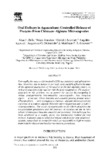Oral delivery in aquaculture: Controlled release of proteins from chitosan-alginate microcapsules
- Global styles
- MLA
- Vancouver
- Elsevier - Harvard
- APA
- Help
Share
抄録
Potentially, the most useful method of fish vaccination is oral administration. However, this technique is presently only partially effective because of the apparent destruction of the vaccine in the fish digestive system, as well as interaction of the vaccine with the feed components. The authors' approach to this problem was to protect the vaccine by entrapping it within semi-permeable biocompatible microcapsules. Two bioactive agents — a vaccine, Vibrio bacterin and a model protein, bovine serum albumin (BSA) — were entrapped in chitosan-alginate microcapsules by extrusion of a sodium alginate/bioactive agent suspension into a CaCl2/chitosan solution. The results of experiments on the effects of varying the encapsulation parameters and the presence of enzymes on the in-vitro release of entrapped bioactive material are presented. This technique has been developed as a simple, quick, and inexpensive method for oral delivery. Capsules may be dried and mixed with feed for ease of administration, particularly to young fish which are susceptible to high mortality from both the disease and harsher vaccination procedures.
Suggested Citation
Polk, A. E., Amsden, B., Scarratt, D. J., Gonzal, A., Okhamafe, A. O., & Goosen, M. F. (1994). Oral delivery in aquaculture: Controlled release of proteins from chitosan-alginate microcapsules. Aquacultural Engineering , 13(4), 311-323. https://doi.org/10.1016/0144-8609(94)90018-3
Type
ArticleISSN
0144-8609Collections
- Journal Articles [1258]


